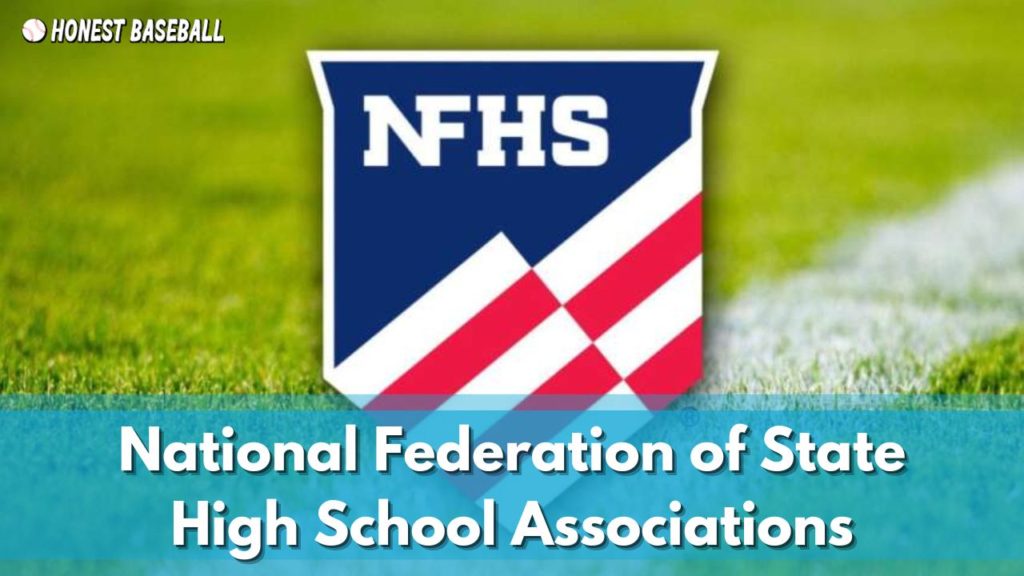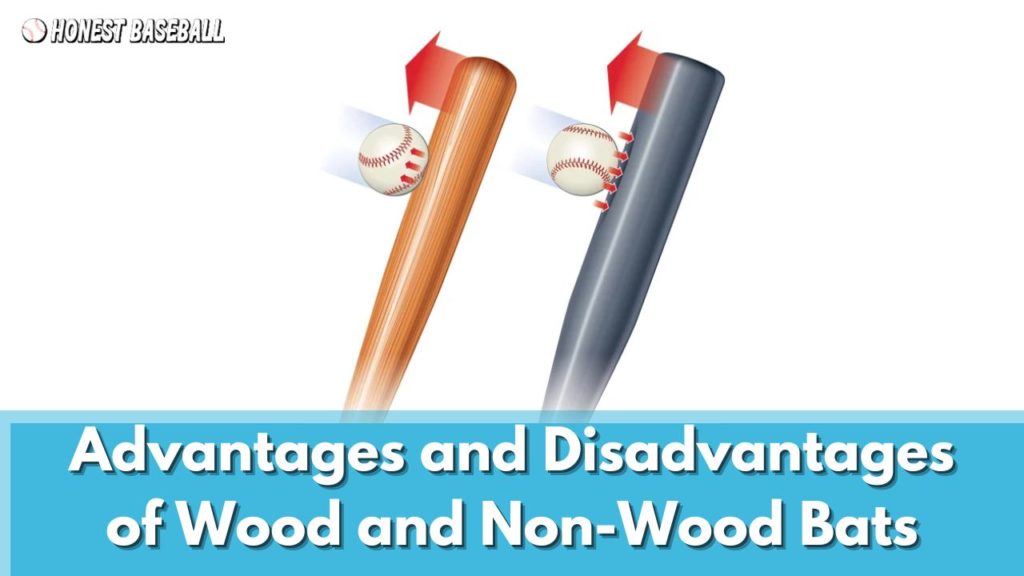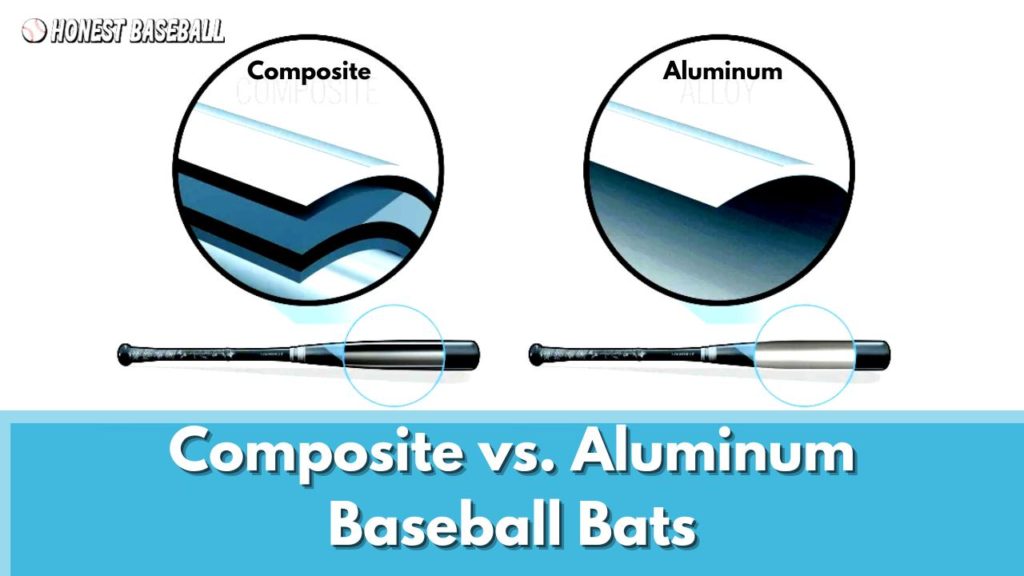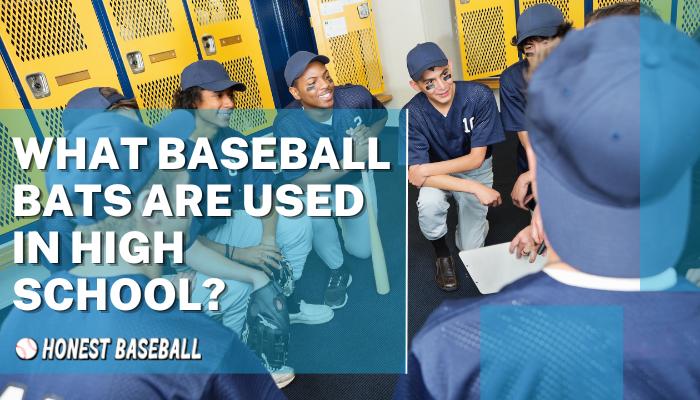As a high school baseball coach and former minor league player, I have seen firsthand the impact that using the right bat can have on a player’s performance.
However, not all bats are created equal, and it is essential to understand what baseball bats are used in high school before starting your career in this league.
A well-balanced and adequately sized bat can improve a player’s swing speed, power, and control, giving them a better chance to make solid contact and hit the ball with authority.
But using the wrong bat can have the opposite effect, leading to weaker swings, less control, and fewer hits.
Lastly, you have to use a bat that meets the rules and performance standards of the baseball league.
In this article, I’m gonna share detailed information regarding every aspect of high-school baseball bats. Let’s head into it.
At a Glance:
- NFHS Controls the Rules And Regulations of High School Baseball Bats
- Understanding the Rules and Regulations of Baseball Bats in High School Sports
- Advantages and Disadvantages of Wood and Non-Wood Bats in High School Baseball
- Composite vs Aluminum Baseball Bats for High School Athletes
- Choosing the Right Baseball Bat for High School Players: Tips and Considerations
- 3 Best Baseball Bats for High School Players
NFHS Controls the Rules And Regulations of High School Baseball Bats

As mentioned in the title, the rules and regulations of high school baseball bats are typically controlled by the National Federation of State High School Associations (NFHS).
It’s a non-profit organization that serves as the national governing body for high school sports in the United States.
They develop rules and guidelines for different high school sports, including baseball, and promote the benefits of participation in high school sports for student-athletes.
The organization comprises 51 state high school associations, including one for each state and the District of Columbia.
NFHS works with these state associations to ensure consistency and uniformity in high school sports rules and regulations across the country.
“Local state associations may also have their own specific rules and requirements related to baseball bats that must be followed in addition to the NFHS rules.”
In addition to developing and updating rules for high school sports, the authority also provides education and training for coaches, officials, and administrators.
The goal is to ensure that they have the knowledge and skills necessary to lead and manage high school sports programs.
Without that, the organization also advocates for the importance of physical activity and the positive impact that high school sports can have on student-athletes lives.
Overall, the NFHS plays a critical role in promoting and supporting high school baseball in the United States and ensuring a safe, fair, and enjoyable sport.
Understanding the Rules and Regulations of Baseball Bats in High School Sports
It is vital for players, coaches, and parents to be aware of these rules and regulations to ensure that the bat used in high school baseball meets the appropriate standards for performance and safety.
However, the rules and regulations of baseball bats in high school sports may vary slightly depending on the league or association, but generally, the following guidelines apply:
Section 3, Art 2, (a)
In order to be deemed legal, each bat, whether crafted from wood, aluminum, or composite materials, must adhere to certain characteristics and features. The bat must meet the following specifications:
- Permanent Assembly
Firstly, it must be fashioned as a single, multi-piece construction that is permanently assembled or as a double-piece bat with an interchangeable barrel structure.
- No Damage Causing Attachments
In addition, the bat cannot have any exterior attachments, rivets, pins, rough edges, or any other potentially hazardous protrusions that may cause a danger to players.
Furthermore, the bat must be free from rattles, dents, burrs, cracks, and sharp edges.
- Broken/Modified = Illegal
Any bats that have been broken, altered, or that are capable of defacing the ball are considered illegal.
The use of any materials, treatments, or devices designed to modify the specifications of the bat and enhance its performance is strictly prohibited and renders the bat illegal.
In order to ensure the safety of all players, these regulations must be followed at all times.
Section 3, Art 2, (b)
All approved wood, aluminum, or composite bats must include the following elements:
Knobs Restrictions
Knobs shall extend from the handle and be fused, molded, turned, or fastened in place without becoming flush with the handle.
While wrappings are allowed, a rubber knob and bat grip combination in one piece is not permitted. Also, they should not in any way create a flush appearance.
Handle Restrictions
Your bat handle can start from the knob but excludes it and finishes where the taper area begins.
Barrel Restrictions
If you don’t know, the barrel is the bat’s area that is designed for making contact with the ball.
It is obligatory for the barrel to have a circular, symmetrical cylindrical shape and a smooth profile.
Even though it can be made from different materials such as aluminum, wood, or composite, it should have the same material used in other parts of the bat.
Taper Restrictions
The taper is a baseball bat’s area that joins the slender handle to the larger part of the barrel.
While the composition of a taper can be different, it should not be more than 18 inches of distance from the knob area.
End Cap Restrictions
The end cap of a bat is a vital component. It not only provides a secure and permanent seal to the end of the bat but also prevents any tampering or modification of the bat that could potentially compromise its performance or safety.
“According to NFHS, the end cap of a baseball bat can only be made out of vinyl, rubber, plastic, etc. relevant materials.”
To keep it unremovable, the approved bat should have a fixed and permanent placement on the bat’s head.
Section 3, Art 2, (c)
NFHS regulations for bats that are made out of multiple materials should maintain the following traits:
Bat Length, Weight
There are also some newly added rules for the bat’s length, size, and weight by NFHS. These are:
- NFHS bat rules mandate that any bat made of multiple wooden materials can have a maximum diameter of 2 5/8 inches, considering the thickest part
- When it comes to the bat’s length, it should not exceed 36 inches.
- For a bat’s weight, they are permitted a numerical value that cannot be more than 3 oz. of the bat’s length.
“For example, a bat that is 36 inches long cannot weigh less than 33 ounces. These rules help ensure that the bats used in high school baseball games meet specific standards and are fair for all players.”
Grip Construction
Bats’ grips should have tape or cork construction. Also, they should not have a smooth plastic design. There is also a restriction for using commercial composite materials in the grip area of a bat.
“Your bat must not have any slippery tape or other material that causes it to become slippy.”
However, high school baseball bats can have drying agents, resin or pine tar, or similar materials that help players to get firmer gripping. But any sort of molded grips is not allowed.
Grip Size
When it comes to grip size, it should have a minimum of 10 inches in length, but not exceeding 18 inches, from the knob’s starting point.
Section 3, Art 2, (d)
Even for label or certification marking, NFHS has some strict rules for players. These are:
- If the bat is made of multi woods, it should meet minimum performance measures set by the BBCOR (Batted Ball Coefficient of Restitution.)
- There should be the labeling of certification by authorized testing organizations, such as USA Baseball.
- In terms of labeling stability, it should be permanently fixed.
- The label paper material should be silkscreen.
- For both wooded and non-wooden bats, labeling with the BBCOR logo is strictly prohibited.
- The shape of the label should be rectangular.
- It should not be more than 1 inch in size.
- The label should be placed on 2 sides of the bat.
“Without these, the National Federation of State High School Associations is also suggested to not allow doctoring bats as they may result in criminal activities.”
Section 3, Art 3
Under this section, NFHS also mentioned some restrictions regarding single-piece wooden bats.
For example, single-piece wooden bats can have tape or roughness within 18 inches of the handle, but no foreign substances beyond that point.
It must also comply with a maximum diameter of 2¾ inches and a length of 36 inches or less.
Section 3, Art 4
The rules regarding the use of equipment during warm-up in baseball and softball can vary, but typically, only bats are allowed for use. This includes weighted bats that are designed for warm-up purposes.
However, it is essential to note that any foreign object that is not meant to be a part of the bat is not allowed during warm-up.
In addition, certain items that are designed to be a part of the bat are also permissible during warm-up. These can include;
- Batting donuts are weighted rings that slide onto the bat and provide additional weight for warm-up swings.
- Wind-resistant devices, such as “bat sleeves,” reduces drag and vibration during a swing and can also be used during warm-up.
While warming up, players should always use equipment approved by the league and comply with the game’s rules. This not only helps prevent injury but also ensures that the game is played fairly for all players involved.
Advantages and Disadvantages of Wood and Non-Wood Bats in High School Baseball

From the above discussion, you learned that you can use both wooden bats and non-wood bats in high school baseball. But before settling for one, you should understand their pros and cons. Here is a brief on that:
Wooden Baseball Bats
Baseball bats are typically made from one of several types of hardwoods, such as ash, maple, birch, hickory, or oak. Each type of wood has its own unique characteristics and properties that affect the bat’s performance.
Advantages of Wood Bats
- More traditional and authentic feel to the game.
- Inexpensive and easily accessible, especially for amateur players.
- Require greater skill and technique to use effectively, which can improve a player’s overall game.
- Offer a consistent weight and balance that may help improve hand-eye coordination and timing.
Disadvantages of Wood Bats
- Less forgiving than non-wood bats, making them more challenging to hit with and resulting in fewer home runs.
- Being more prone to breakage can lead to extra expenses for players and teams.
- Can be heavier than non-wood bats, which can lead to fatigue and decreased performance.
Check out: 7 Best Wood Bats That a Coach Selected
Non-wooden Baseball Bats
Non-wooden baseball bats can be made from a variety of materials, including aluminum, composite materials, and other metals.
Because of their contemporary design, they provide some playing benefits, though misses some goods of traditional wood bats. Let’s look at them;
Advantages of Non-Wood Bats
- Lightweight, making them easier to swing and resulting in increased bat speed.
- Offer a more prominent “sweet spot,” resulting in more hits and home runs.
- More durable and less likely to break compared to wood bats, making them more cost-effective in the long run.
Disadvantages of Non-Wood Bats:
- Less traditional and authentic feel, which can take away from the game’s overall experience.
- More expensive and less accessible than wood bats.
- Can create safety concerns due to the increased ball speed, which can result in serious injury.
Choosing between a wood bat and a non-wood bat in high school baseball depends on personal preference, skill level, and budget.
While wooden bats are more traditional and less expensive, non-wood bats offer increased performance and durability but at a higher cost.
Composite vs. Aluminum Baseball Bats for High School Athletes

Since different types of non-wooden bats are used in high-school baseball, it is essential to understand their feature benefits thoroughly.
Basically, non-wooden bats are made of either composite or aluminum materials. Let’s take a quick look at them;
Performance
Composite bats tend to have a larger sweet spot, which can make it easier for players to make solid contact with the ball.
They also tend to have less vibration and sting upon contact, making the player more comfortable.
.
On the other hand, aluminum bats tend to be stiffer and provide less trampoline effect. However, some players may prefer the feel and sound of hitting with an aluminum bat.
Durability
As a coach, I should admit that composite bats are less durable than aluminum bats. They can crack or break more easily.
This can be a concern for high school baseball players who use their bats frequently and may not have the budget to replace them as often.
Cost
When it comes to pricing, composite bats tend to be more expensive due to their advanced technology and materials.
Moreover, only a few brands manufacture good quality composite bats that you can bet on confidently.
Because of the price efficiency, aluminum bats are accessible to many players. Therefore, you will find lots of brands rumbling in this segment.
Weight
Aluminum is lighter than typical metals. But composite bats are even lighter because of a blend of less weighty materials such as carbon fiber.
Though the vote goes to composite bats, many players prefer the heavier feel of an aluminum bat.
Check out: Alloy VS Composite Bat Basic
Choosing the Right Baseball Bat for High School Players: Tips and Considerations
This section will guide you about which key features you should consider when choosing baseball bats for your high-school career.
Length and Weight
Choosing the right length and weight of a baseball bat is crucial for high-school baseball enthusiasts. Having an adequate bat length and weight ensures they can swing comfortably and with reasonable control.
Generally, the bat’s length should not exceed the player’s wrist when their arm is extended,
And for the bat’s weight, nothing has more priority than a player’s comfort. And you cannot actually make the right decision with your first bat. So, it is better to experiment with the bat’s weight. However, go with lightweight picks initially.
Bat Material
As mentioned earlier, there are three main types of materials used for baseball bats – wood, aluminum, and composite. Hence, I will not go about the pros and cons or features.
Nowadays, wooden bats are typically used in professional leagues, while aluminum and composite bats are more common in amateur leagues. I suggest going according to your budget.
League Regulations
While NFHS rules are a general guide for baseball bats, high school players also need to follow their league’s rules. So, before purchasing a bat, you should check out the tournament’s additional rulebook.
Grip
The grip of a bat can affect a player’s swing and overall performance. Players should choose a grip that is comfortable for them and provides enough friction to prevent the bat from slipping out of their hands.
Some players prefer a thicker grip for better control, while others prefer a thinner grip for more feel. Experiment with different grip types to find the one that works best for you.
Bat Certification
The bat certification logo is a mark or stamp that is placed on a baseball bat to indicate that it has been certified by the governing organization that oversees the rules and regulations of baseball.
These indicate that the bat meets the standards for size, weight, material, and performance that have been set forth by the organization.
For example, it may have a USABat or USA Baseball label on both sides of the bat.
Brand and Price
While brand and price are not the most critical factors in choosing a baseball bat, they can still be important considerations for some players. As a first-timer, you should only invest in a reputable brand to get the most out of your bucks.
In this list, I prefer having Easton, Rawlings, DeMarini, Louisville Slugger, and Marucci.
3 Best Baseball Bats for High School Players
Finally, to help you find the best baseball bat for high-school gameplay, I have shortlisted my 3 most favorite gigs in this section. Let’s check out what makes them stand out.
1. Easton Speed BBCOR Aluminum Baseball Bat
Highlights
- Material: ALX50 Aircraft Grade Alloy
- Forged End Cap
- Grip: 2.2mm Flex
- Color: Navy Blue, Green
- Size: 30 to 34 inches
The Easton SPEED is an excellent option for serious baseball players looking for a high-quality bat.
Made in the USA, this bat boasts a single-piece aluminum build using ALX50 aircraft-grade alloy material, providing a balanced and durable design that can handle the demands of the game.
The aluminum construction ensures that the bat is lightweight and easy to swing while providing ample power for hitting.
Without that, it features a forged end cap that optimizes the sweet spot, making it easier to hit the ball farther and with more power.
Additionally, the cushioned grip ensures that you can maintain a comfortable and secure hold on the bat, which is essential for control and accuracy at the plate.
Overall, the bat’s design is ideal for players who want a dependable and performance-driven option.
Pros
- ALX50 aircraft-grade alloy built, which can withstand the rigors of the game
- 1-piece aluminum design that makes it easier to swing and control
- Forged end cap optimizes the sweet spot and increases the hitting percentage
- Flex grip enables a comfortable and secure hold on the bat
- Approved for play in all BBCOR Baseball Leagues
Cons
- Does not provide as much trampoline effect as composite bats
2. Louisville Slugger 2020 Vapor BBCOR Baseball Bat Series
Highlights
- Material: Composite
- HUB 1-shot End Cap
- Grip: Synthetic Leather
- Color: Black
- Size: 30 to 34 inches
The Louisville Slugger 2020 Vapor series is another excellent option for high-school baseball players. One of the advantages of this bat is its drop weight of -3, which makes it suitable for high-school baseball play.
It features a Series 7 alloy barrel with a 2 ⅝-inch diameter, which provides excellent pop and performance on contact. Besides, with the support of the HUB 1-shot end cap, it maintains its structural integrity.
In addition to its design, it is also a one-piece construction, which makes it durable and reliable. Although some users have reported that the bat can produce significant vibration if the ball is hit incorrectly, this is a common issue with one-piece bats.
This bat is also praised for its price point; compared to the features, it provides more incredible value.
Unlike the Easton, it has a standard synthetic leather grip that provides. Though it is high-quality, some newbies may find it a little slippery.
Its size range of 30 to 34 inches ensures that players of different heights and preferences can find a suitable fit.
Pros
- Provides excellent pop and performance on contact with a large barrel
- Comes with different size options
- Makes swinging balance easy to control with the end-cap design
- Unbreakable alloy barrel with a blend of composite materials
- -3 drop weight feature gives a lightweight feel
Cons
- Create heavy vibration when shot incorrectly
Marucci CAT9 Pastime -3 BBCOR Metal Baseball Bat
Highlights
- Material: Aluminum
- AV2 Anti-Vibration Knob
- Grip: Micro-perforated
- Color: USA Pastime
- Size: 30 inches
Let’s wrap up my selection with the Marucci CAT9. Whether for practice or a big day event, there is nothing more powerful than this high-school baseball bat. Wondering why?
The first thing that makes it a step ahead of other bats is its anti-vibration knob design. As mentioned earlier, it is the most annoying trait in aluminum-made bats. So, you can expect to avoid the issue.
Digging deeper into its construction and durability also sets a milestone for others. It is made with thermally treated AZR alloy, which is nothing but a season of commitment.
Another great aspect of this bat is its thinner barrel walls. It ensures you get an improved responsiveness every time hitting a ball. This trait is crucial when you want to enhance your batting skill.
The removable taper also allows for a customizable feel so that the player can adjust according to their style and comfort.
To increase comfort, it comes with a micro-perforated grip, allowing for better sweat absorption and improved durability.
Pros
- Anti-vibration knob for reducing the impact on palms and hands
- Thermally treated AZR alloy built for seasons of service
- Thinner barrel structure for better response on hitting
- Removable taper allows customization on the handle
- Sweat-absorbing grip for longer uses
Cons
- A very high price tag makes it unaffordable for budget seekers.
Check out: Top Picks for the Best Baseball Bats for High School Players
Frequently Asked Questions
What is the best high school baseball bat?
If considering the performance, built quality, and price, the Easton Speed series is the best high-school bat right now in the market.
What kind of bat should a 14-year-old use?
For 14-year-old baseball players, a bat size of 31 to 33 inches is adequate. They can use both composite or aluminum bats.
What size bat do most high school players use?
Most high-school baseball players use bat sizes starting from 31 to 32 inches. However, depending on their height and hand-to-hand distance ratio, they can also go for 33 to 34 inches bats.
Are heavier bats better for high-school players?
Heavier bats provide a faster swing speed. As a result, they hit the ball faster. In this context, heavier bats are even better than lightweight bats.
However, because of that, players have to be more skilled to achieve accurate hitting. They also need to have enough strength to control the bat’s balance.
Wrapping Up
It is time to conclude this long discussion on “what baseball bats are used in high school.” I have tried to share all high-school bat rules and why they matter. Besides, you have also learned about different types of bats and their pros and cons.
At last, I have shared the 3 best baseball bats for high school players. Hopefully, you have found this article enough informative and helpful. Take care.
Check more essentials on baseball batting:
8 Best Youth Baseball Bats to Let Your Kids Step Up on the Plate!
5 Best Baseball Pitching Machines in 2023| Personal Reviews by A Coach
Louisville Slugger Meta 2022 USSSA Bat Review | Everything Explained

Hello everyone. My name is Jason Butler, and I live in California, America. I was a professional AAA Minor League Baseball player. I lost my chance of playing MLB for injury issues, but I did not lose my love for baseball. I attended the coaching training program and am now working as a coach in a small school in San Diego.
I always love to share my experience and knowledge if that can help you. Play baseball, and stay fit.



